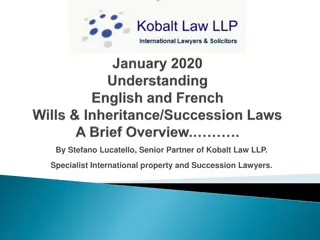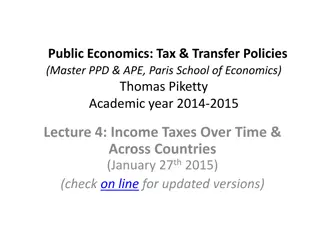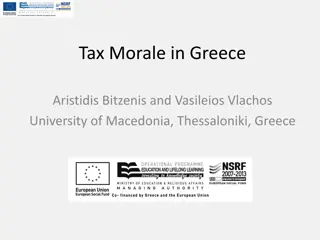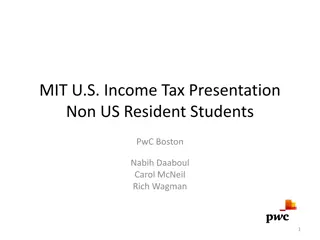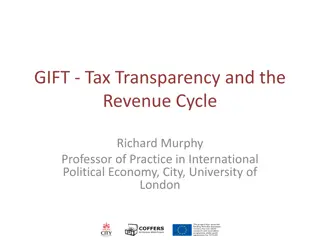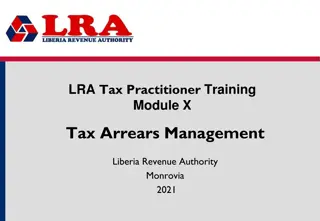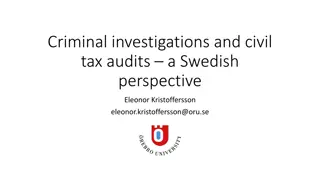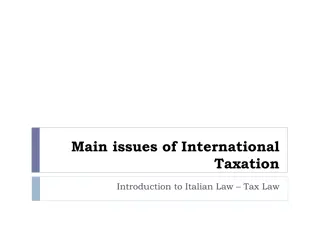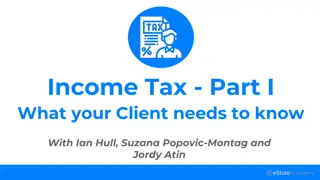Understanding Basic Partnership Tax Law
Explore the fundamentals of partnership taxation according to the Tax Law Section of the Sacramento County Bar Association. Learn about the definition of a partnership, individual versus entity taxation, entity classification rules, and the different types of partnerships for tax purposes.
Download Presentation

Please find below an Image/Link to download the presentation.
The content on the website is provided AS IS for your information and personal use only. It may not be sold, licensed, or shared on other websites without obtaining consent from the author. Download presentation by click this link. If you encounter any issues during the download, it is possible that the publisher has removed the file from their server.
E N D
Presentation Transcript
THE SACRAMENTO COUNTY BAR ASSOCIATION, TAX LAW SECTION BASIC PARTNERSHIP TAX THE CLIFF S NOTES VERSION October 26, 2015
Basic Partnership Tax -- The Cliff s Notes Version Tax Law Section of the Sacramento County Bar Association Douglas L. Youmans Wagner Kirkman Blaine Klomparens & Youmans LLP 10640 Mather Blvd., Suite 200 Mather, CA 95655 Phone: (916) 920-5286 Fax: (916) 920-8608 Email: dyoumans@wkblaw.com
What Is A Partnership? CA Law/Uniform Partnership Act Association of 2 or more persons to carry on as co-owners a business for profit Code1 761(a): includes a syndicate, group, pool, joint venture, or other unincorporated organization through, or by means of which any business, financial operation, or venture is carried on and which is not within the meaning of this title, a corporation or trust or estate. _________________________________________ 1All references to Code sections are to the Internal Revenue Code of 1986, as amended 3
Individual or Entity? Aggregate Concepts Only the partners are subject to tax in their individual capacities (Code 701) Each partner only accounts for his/her distributive share of partnership income (Code 702) Entity Concepts Partnership has its own taxable year Certain events must occur to terminate partnership (Code 708) Partner may engage in transactions with the partnership in a capacity other than as a member Most tax elections made by partnership 4
Check the Box: Which Entity? Non-corporate entity owners may generally choose how the entity is to be taxed by making an election on and filing IRS Form 8832 Ex: LLC s must make an affirmative election to be taxed as a corporation Default Rule for Unincorporated Entities: 2+ owners: taxed as a partnership 1 owner: entity is disregarded and treated as a sole proprietorship (if the owner is an individual) or as a branch or division of another entity Kinds of Partnerships (for tax purposes) General Partnerships Limited Partnerships Multiple Member LLCs that do not elect to be taxed as corporations 5
(LLC) Reporting Requirements LLCs: CA Returns LLCs taxed as corporations: CA Form 100 $800 annual minimum tax LLCs, absent S election, will be taxed at CA corporate tax rate LLCs taxed as partnerships/disregarded entities: CA Form 568 $800 annual minimum tax (CA Form 3522) Gross receipts tax (CA Form 3536) Non-CA resident members (CA Form 3832) Member/owners of disregarded entities: Individuals: IRS Form 1040, Schedule C, C-EZ or E Corporations: IRS Form 1120 or 1120S 6
LLC Gross Receipts2 Tax Fee $ 900 $ 2,500 $ 6,000 $11,790 Total California Source Income $ 250,000 - $ 499,999 $ 500,000 - $ 999,999 $1,000,000 - $4,999,999 $5,000,000 or more 2NOT"Taxable" or "Net Income 7
Partnership Formation Creation of a Partnership: By (written) agreement or Through business agreements and activities Partnership Interests: Contributions are made in exchange for interests in the partnership Examples: Cash, property, sweat equity General Rule: No gain or loss upon contribution Built-in gain/loss ultimately taxed to contributing partner Exceptions: Certain contributions of encumbered property (Code 731(a) and 752(b)) Disguised sales (Code 707(a)) 8
All About that Basis Basis is important!!! Basis helps determine the tax consequences of: Sales (of partnership interests) Partnership distributions; and Deductibility of partnership (pass-through) losses (Code 704(d)) Inside vs. Outside Basis: Inside: The partnership s basis in the assets in the partnership. Outside: A partner s basis in his/her or its partnership interest (owned outside of the partnership). 9
Computing Outside Basis A partner s outside basis includes: Partnership Interests acquired by Purchase: Cost basis. Partnership Interests acquired by Contributions: Cash contributions by the partner; The contributing partner s basis in any property contributed (FMV is irrelevant); and The amount of gain, if any, recognized by the partner on the contribution. (Code 722.) Example 1 (Outside Basis): Emily and Scott each contribute $50 to a new partnership, E&S, in exchange for their respective E&S partnership interests. Emily and Scott each have a $50 outside basis in their respective E&S partnership interests. Assume, instead, that Emily contributed $25 in cash and property with a basis of $25 (the FMV of the property may or may not match its basis). Emily would still have a $50 outside basis in her E&S partnership interest ($25 cash plus the $25 basis in the property she contributed). Assume, now, that Emily contributed $25 in cash and property with a basis of $0 (and a FMV of $25). In this case, Emily would only have a $25 outside basis in her E&S partnership interest ($25 cash plus the $0 basis in the property). 10
Computing Outside Basis (Cont.) Treatment of Liabilities (Code 752). The simplicity related to ( tax ) accounting for property contributions is lost when contributed property is subject to a liability. If the partnership assumes a contributing partner s liability or takes contributed property subject to a liability, the liability relief afforded the contributing partner (allocated to other partners under Code 752) is treated as a cash distribution to the contributing partner (under Code 752(b)). This deemed distribution decreases the contributing partner s outside basis (Code 733), but not below zero (basis never goes negative/below zero). Any deemed cash distribution in excess of the contributing partner s outside basis generates taxable capital gain under Code 731(a)(1) and 741. 11
Computing Outside Basis (Cont.) Example 22 (Outside Basis): A acquired a 20% interest in a partnership by contributing property. At the time of A s contribution, the property had a fair market value of $10,000, an adjusted basis to A of $4,000, and was subject to a mortgage of $2,000. Payment of the mortgage was assumed by the partnership.3 The outside basis of A s interest in the partnership is $2,400, computed as follows: A s adjusted basis in property contributed $4,000 Less: debt relief equal to that portion of the mortgage assumed by other partners (treated as a distribution to A (80% of $2,000)) (1,600) Outside basis of A s interest $2,400 _________________________________________ 2 From Income Tax Regulations ("Regs.") 1.722-1, Example (1) 3 When Contributed Property is subject to debt, the debt is deemed to have been assumed by the Partnership 12
Computing Outside Basis (Cont.) If, in Example 2, the property contributed by A was subject to a mortgage of $6,000, the outsidebasis of A s interest would be zero, computed as follows: A s adjusted basis in property contributed $4,000 Less: debt relief equal to that portion of the mortgage assumed by other partners (treated as a distribution to A (80% of $6,000)) (4,800) A s liability relief in excess of basis $ (800) Since A s (outside) basis cannot be less than zero, the $800 by which A s liability relief exceeds his basis in the property contributed (which liability relief is treated as a distribution of money under Code 752(b)) is treated as capital gain from the sale or exchange of a partnership interest. See Code 731(a). _________________________________________ 2 From Income Tax Regulations ("Regs.") 1.722-1, Example (1) 13
Outside Basis and Liabilities Effect on Contributing Partner: Partnership assumes liability: Deemed distribution to contributing partner and decreases partner s outside basis. Liability in excess of a contributing partner s outside basis which is allocated to other partners is taxable to contributing partner. Effect on Other Partners: Outside basis of each noncontributing partner is: Increased by his, her or its respective share of the contributing partner s liabilities which the partnership assumes or takes subject to; and Decreased by the portion of his, her or its share of partnership liabilities which are reallocated to the contributing partner. 14
Outside Basis and Liabilities (Cont.) Example 3 (Effect of assumption of liabilities on other partners): Assume AB Partnership: Blackacre Outside Basis: A B 100 Mortgage/Debt Equity 100 0 50 50 Assume C contributes 100 cash for a 50% interest: Cash Blackacre 100 100 Mortgage/Debt Equity 100 100 Outside Basis: A B C 25 25 150 Adjustments to Basis: A partner s outside basis needs to be adjusted to reflect tax items (i.e. income, gain, loss and deductions from partnership operations), distributions and subsequent contributions. 15
Capital Accounts & Adjustments Capital Accounts: Represent the partners equity in the partnership Outside basis is not necessarily = Capital account Partnership liabilities are not reflected in capital accounts Capital Accounts are periodically adjusted to properly reflect the value of each partner s interest in the partnership Increased by the partner s contributions and the partner s share of partnership income and gain Decreased by the partner s share of partnership loss and distributions 16
Capital Accounts & Adjustments (Cont.) Example 4 (Capital Accounts): Assume that Emily and Scott form E&S (as described in Example 1, above), and each contributes $50 cash. Emily and Scott agree to share all E&S profits and losses. E&S s initial balance sheet would be as follows: 17
Capital Accounts & Adjustments (Cont.) Example 5 (Capital Accounts): Assume, now, that E&S buys property for $200 , paying $100 in cash and borrowing $100. Assume, also, that E&S earns $50 from its operations. After these transactions, E&S s balance sheet would look as follows: Assets Liabilities Book Value Book Value Cash $ 50 $ 100 Property $ 200 Capital Accounts Book Value Emily $ 75 Scott $ 75 $ 150 NOTE: Although Emily and Scott s capital accounts each increase by their respective shares of the partnership s $50 worth of income, neither capital account is affected by the loan 18
Inside Basis The partnership takes the contributing partner s basis in the property contributed: i.e., the partnership has the same (inside) basis in the property contributed that the contributing partner had immediately prior to the contribution. (Code 723.) The Partnership s inside basis in its assets remains unaffected by the realization of gain by the contributing partner. Code 754 election can be affirmatively made to adjust the basis of partnership assets under Code 734(b). 19
Inside Basis (Cont.) Example 6 (Inside Basis): Assume Emily contributes to E&S $25 in cash and property in which she has a basis of $25. E&S would have an inside basis in the contributed property of $25. Assume, instead, that Emily contributes $25 in cash and property with a basis of $0 and FMV of $25. In this case, E&S would have an inside basis in the contributed property of $0. 20
Partnership Income Partnership is not subject to tax at the entity level But elections affecting the computation of partnership taxable income must be made at the partnership level Phantom Income results where partnership income is allocated among partners but the partnership does not distribute any cash Distinguish income allocations from (cash) distributions Computation of Partnership Taxable Income (Code 703(a)): The taxable income of a partnership shall be computed in the same manner as in the case of an individual except that Certain Items are separately stated: Code 702(a): Capital gains/losses, charitable contributions, dividends, etc., are reported to the partners on K-1s Certain deductions are not allowed: Code 703(a)(2): Personal exemptions, charitable contribution deduction, NOL deduction, etc. 21
Partnership Taxable Year & Reporting Partnership Taxable Year: Determined at the partnership level (Code 706) Majority interest taxable year(Code 706(b)(4)(i).) The term majority interest taxable year means the taxable year which constituted the taxable year of 1 or more partners having an aggregate interest in partnership profits and capital of more than 50 percent. (Emphasis added.) Taxable year of principal partners (Code 706(b)(3).) For the purpose of this subsection, a principal partner is a partner having an interest of 5 percent or more in partnership profits or capital. (Emphasis added.) Calendar year Other valid business purpose 22
Partnership Taxable Year & Reporting (Cont.) Partnership Returns: IRS Form 1065, US Return of Partnership Income Reports each partner s share of the partnership s income and other tax items on Schedule K-1 California Form 565, Partnership Return of Income 23
Partners Distributive Shares Partners distributive shares are determined by reference to the partnership agreement BUT allocations must be consistent with the economic/business arrangements among the partners Consider: Varying Interests During Tax Year Because of transfers (sales, exchanges, gifts, bequests) Special Allocations 24
Varying Interests During Tax Year Allocations must take into account varying interests of the partners in the partnership during the taxable year (Code 706(d)(1)) Two Methods: Interim Closing of the Books: Default method Partnership allocates items of income or loss as if it had closed its books on the date of the change in ownership (even though its taxable year remains open) Proration: Alternative method Partnership determines each partner s share of the partnership s tax items for the year by proration, based on the number of days of the year each respective partner owned the interest which was transferred 25
Varying Interests During Tax Year (Cont.) Example 7 (Varying Interests/Proration Method): If P1 transferred P1 s partnership interest to P2 on May 31 of a given year, P1 would be allocated 41.37% (151/365 = 41.37%) of the P1/P2 distributive share of the partnership tax items for that year and P2 would be allocated the other 58.63% (214/365 = 58.63%) of the P1/P2 distributive share of those items for that year Hypo 7A: Partnership only engages in 1 transaction, a sale on 2/1, generating $1,000,000 worth of gain. P1 transfers to P2 on 2/2. Who wants to close the books? Who wants to prorate? 26
Special Allocations Special allocations must (i) be reflected in the partnership agreement; and (ii)have substantial economic effect( SEE ) (Code 704(b)) SEE = whether allocation affects dollar amount of the partners shares of the total partnership income or loss independently of tax consequences Three Tests: Test 1: Allocation must have SEE; Safe harbor for allocations, mechanical, and well-defined Test 2: Allocation must be in accordance with the partners interests in the partnership ( PIP ); or Default rules for allocations that do not meet the SEE safe harbor Test 3: Allocation must be deemed to be in accordance with the PIP pursuant to certain special rules ( Deemed PIP ). 27
Test 1: SEE (Regs. 1.704-1(b)(2)) Prong 1: Does the allocation have economic effect ( EE )? General rule: EE exists if the partnership establishes capital accounts and maintains them in accordance with the Regs. Basic Test 1. Capital accounts must be maintained pursuant to Regs. 1.704-1(b)(2)(iv); 2. Liquidating distributions must be made in accordance with the respective partners positive capital account balances; and 3. Deficit makeup requirement upon liquidation. Alternate Test 1 & 2. First 2 steps same as Basic Test; 3. Loss limitation provision: Allocations can t cause/increase a deficit balance in a partner s capital account (in excess of any amount of such deficit that the partner is obligated to restore) as of the end of the partnership taxable year to which the allocation relates; and 4. Qualified income offset provision: Any partner who unexpectedly receives certain adjustments, allocations, or distributions will be allocated items of income and gain to eliminate any deficit balance. Economic Effect Equivalence Test Liquidation of partnership at the end of the year in which the allocation takes place produces same results that would occur if Basic Test were met 28
Test 1: SEE (Cont.) Prong 2: Is the EE of the allocation substantial ? Subjective test: Is there a reasonable possibility that the allocation will affect substantially the dollar amounts received by the partners independent of any tax consequences? General rule: An allocation is deemed substantial if there is a reasonable possibility that it will affect the amount of money that partners will receive independent of tax consequences Example: If a tax savings occurs for one or more partners in the partnership and the economic sharing arrangement is unaltered, then the allocation probably lacks substantiality. 29
Test 2: PIP (Regs. 1.704-1(b)(3)) General Rule: Determine the true economic sharing arrangement of the partners based on all of the facts and circumstances Factors considered: Partners relative contributions to partnership; Interests of partners in economic profits/losses; Interests of partners in cash flow and other non- liquidating distributions; and Rights of partners to distributions of capital at liquidation 30
Test 3: Deemed PIP (Regs. 1.704-1(b)(4)) General Rule: Special rules are applied for tax items the allocation of which inherently lacks economic effect because there is no economic consequence to the tax item at issue. Allocations are deemed to be consistent with PIP if made according to the Regs. Example: Applies to allocations of nonrecourse deductions because they do not have a corresponding economic allocation 31
Allocations With Respect to Contributed Property Code 704(c). A contributing partner must remain responsible for inherent tax consequences in contributed property when unrecognized gains or losses at the time of contribution are subsequently realized by the partnership. Example 8: If a partner contributes property with a basis of $4k and a FMV of $10k, upon the partnership s subsequent sale of the contributed property, the contributing partner is allocated the first $6k of the capital gain arising from the sale. To address the disparity between book value of property held by the partnership and its tax basis from the contributing partner, the Regs. require maintenance of tax capital accounts for the partners which reflect each partners share of the partnership s inside basis in its assets (net of liabilities). 32
Basis: Limitations on Loss Deductions A partner s distributive share of partnership loss is allowed as a deduction only to the extent of their outside basis at the end of the partnership year in which the loss is incurred. (Code 704(d).) Such disallowed losses may be carried forward (indefinitely) until sufficient basis is available to permit their deduction. Example 9: Assume ES partnership (50/50) E s outside basis = 0 ES partnership experiences a $2,000 loss E cannot recognize her $1,000 distributive share of that loss unless/until her outside basis is increased. Planning options? 1. Have E contribute $1,000 in cash (before year end). 2. Specially allocate 100% of the loss to S. 3. ??? 33
At Risk Rules: Limitation on Loss Deductions Partners may not deduct losses from an activity to the extent that the losses exceed the amount the partner has at risk in the activity (Code 465). A taxpayer is considered at risk to the extent of: The amount of money and the adjusted basis of property contributed by the taxpayer to the activity (Code 465(b)(1)(A)); and Amounts borrowed with respect to the activity to the extent the taxpayer is personally liable for repayment of the borrowed amount or has pledged property (other than property that is used in the activity) as security for the borrowed amount (Code 465(b)(2)). Note: A partner may have an outside basis sufficient to cover a loss and still be denied a deduction for their share of partnership losses if their outside basis includes a share of the partnership s nonrecourse liabilities because the partner is not personally liable for such liabilities. 34
At Risk Rules: Limitation on Loss Deductions (Cont.) Example 10 (At Risk Limitation on Loss Deductions): Assume ES LLC, taxed as a partnership. E&S are equal (50/50) members. Year 1: ES LLC buys land subject to 100% nonrecourse loan. Blackacre Outside Basis: E S 100 Mortgage/Debt Equity 100 0 50 50 ES LLC incurs an $80 loss. Because E & S are not at risk, neither can deduct their $40 distributive share of the loss unless/until they are at risk (i.e., the loss is carried forward). 35
At Risk Rules: Limitation on Loss Deductions (Cont.) Partnership Tax Items Increase/Decrease Amounts At Risk: A partner s amount at risk is increased by the partner s distributive share of the partnership s income, gain, and tax-exempt income. A partner s amount at risk is decreased by the partner s distributive share of partnership losses, their share of partnership expenses relating to the production of tax-exempt income, and distributions. Example 11 (At Risk Limitation on Loss Deductions/Carryforward): Year 2: ES LLC realizes income of $100. E & S are each allocated $50 as their distributive shares of the income. This (income allocation) puts E & S at risk for $50, allowing each to recognize the disallowed year 1 loss which was carried forward. Net effect : E & S only recognize $10 in income in year 2: Year 2 income Year 1 loss Net income recognized 50 (40) 10 36
At Risk Rules: Other Considerations Limited Partners ( LPs ) and LLC Members: In certain circumstances, LPs and LLC members may be considered personally liable for partnership/LLC liabilities. Determining Factor: Does the ultimate liability for payment rests with the LP or LLC member? If the LP/LLC member is the obligor of last resort then at risk status exists for that liability. Note: A mere guarantee of a recourse liability of the partnership is generally not enough to be deemed at risk. Unlimited Loss Carry-Forwards: Any disallowed losses are carried over to future taxable years (indefinitely) and deductible if/when the taxpayer s amount at risk increases (Code 465(a)(2)). 37
Partnership Distributions: Current or Liquidating? A liquidating distribution: terminates the partner s entire interest in the partnership. (Regs. 1.761- 1(d).) May trigger loss recognition to distributee-partner if distribution is less cash than the distributee-partner s outside basis. Unrealized receivables and inventory are treated as cash for this purpose. A current distribution is any distribution which is not a liquidating distribution. 38
Current Distributions: Gain or Loss? General Rule: Nonrecognition of gain or loss to all parties on distribution of partnership property or money to partners (Code 731) Cash Distributions: Distributee-partner reduces their outside basis by amount of money received. (Code 733.) Exception: Cash distribution in excess of distributee-partner s outside basis is taxable gain to distributee-partner. Exception does not apply to property distributions. Property Distributions: Distributee-partner s outside basis is allocated among properties distributed and their continuing interest in the partnership (Code 732 and 733) which preserves any inherent gain or loss in the property distributed or in their interest in the partnership. Losses: A loss is never recognized in a current distribution. 39
Current Distributions: Basis Effects General Rule: Distributee-partner takes partnership s inside basis in the distributed property and reduces their outside basis in their partnership interest by that amount equal to the sum of (i) any money received; plus (ii) the partnership s inside basis in the property distributed. (Code 732(a) and 733.) Limitation: Basis in property received by distributee-partner cannot exceed distributee-partner s outside basis immediately prior to the distribution reduced by any cash received in the same transaction. (Code 732(a)(2).) If this limit applies, the distributee-partner s basis in the property distributed is equal to the distributee-partner s outside basis immediately prior to distribution, reduced by any actual or deemed cash received; and their outside basis in their partnership interest will be zero. 40
Current Distributions: Basis (Cont.) Example 12 (Current Distribution/Basis): Emily and Scott form E&S as equal partners. Emily receives a current distribution of property from E&S. At the date of distribution, the property has an FMV of $14,000 and an inside basis of $7,500. Immediately prior to the distribution, Emily s outside basis is $12,000. Neither E&S nor Emily recognizes a gain on the distribution. Emily s basis in the property distributed to her becomes $7,500 (i.e., the inside basis of the property to E&S), and her outside basis is reduced to $4,500 ($12,000 - $7,500). Assume, instead, that Emily s outside basis immediately prior to the distribution is $6,000. In this case, Emily s outside basis is not sufficient to match E&S inside basis in the property. Again, neither E&S nor Emily recognizes a gain on the distribution. Upon the distribution, Emily s outside basis is reduced to zero ($6,000 - $6,000), and she takes a basis in the distributed property of $6,000. 41
Distributions in Complete Liquidation of Partnership Interests Taxation. Exception to General Rule with Respect to Recognition of Loss: A liquidating distribution may trigger loss recognition to the distributee-partner if the distribution consists of less cash than the distributee-partner s outside basis. Unrealized receivables and inventory will be treated as cash for this purpose. Basis of Property Received in Complete Liquidation of a Partnership Interest The inside basis of property distributed as part of a liquidating distribution is carried over, and increased when the distributee-partner s outside basis (as reduced by any cash or liability reduction as a result of the distribution) is greater than the property s inside basis. A distributee-partner s basis in unrealized receivables and inventory cannot exceed the inside basis in such property. 42
Sales of Partnership Interests General Rule: The amount and character of gain or loss, basis and holding period are based on the partnership interest held by the selling partner and not on the assets owned by the partnership. Exceptions: Hot assets , collectibles, or Code 1250 capital gain at the time of the sale. (Code 751.) Selling Partner: Recognizes capital gain/loss measured by difference between amount realized and selling partner s outside basis. Buying Partner: Outside basis = cost of partnership interest. Consider additional optional adjustments under Code 743. 43
Partnership Termination (for Federal Income Tax Purposes) (Actual) Termination: When a partnership ceases to do business. (Code 708(b)(1)(A).) Effects: The partnership s taxable year closes upon termination. All partnership assets are treated as distributed to the partners. Deemed Termination: When there is a sale or exchange of 50% or more of the total interests in partnership capital and profits within any 12- month period, regardless of whether it actually ceases to do business. (Code 708(b)(1)(B)). Effects: Old partnership is terminated and a new partnership is formed (Regs. 1.708-1(b)(4)); Taxable year of old partnership ends on date of termination and must file a final tax return; and Restarts any recovery period for depreciable property. 44
Partnership Termination (for Federal Income Tax Purposes) (Cont.) Example 13 (Partnership Termination): Following a deemed termination, a commercial building with a 39-year life, having an original cost of $1,000,000 and 13 years worth of accumulated depreciation of $333,000, would be depreciated by the new partnership over 39 years using an adjusted basis of $667,000. This is often a more complicated issue than a real termination under Code 708(b)(1)(A) because the partnership and the remaining partners may unwittingly carry on the partnership s operations and have to deal with any unintended tax consequences caused by the deemed termination after the fact. 45
Disposition of Partners Interest At Death or Retirement Interests may be Liquidated as part of a complete liquidation of the partnership. Partnership continues to be recognized for tax purposes during the windup period and the partners (or the successors in interest of deceased partners) are treated as partners for tax purposes until the liquidation is completed. Distributions in complete liquidation of a partnership are taxed under Code 731, 732 and 751(b). Disposed of by sale to another partner or to a third party. Consequences to selling partner are governed by Code 741 and 751(a). Liquidated in exchange for distributions from the continuing partnership. Governed by Code 736. 46
Code 736 Payments Code 736 governs payments made by a partnership: (i) To a retired partner, or to a deceased partner s successor in interest; and (ii) In liquidation of their entire interest in the partnership. Death of a Partner: A partnership does not terminate for tax purposes upon the death of a partner (Code 708(b)), and the decedent s successor in interest is recognized as a continuing partner until the decedent s interest is sold or liquidated. (See Regs. 1.706-1(c)(3)(i) & 1.736-1(a)(1)(ii).) Example: If a decedent partner s interest is liquidated as a result of death, the successor to the decedent s interest is treated in the same manner as a retired partner for Code 736 purposes. (See Regs. 1.736-1(a)(1)(i).) Retired Partner: A partner is treated as a retired partner only when they cease to be a partner under local law. A retired partner is treated as a continuing partner until the Code 736 liquidation process is complete. (Regs. 1.736-1(a)(1)(ii) & 1.736-1(a)(6).) The taxable year of a partnership does not terminate with respect to a retired partner until all Code 736 payments have been made. (Regs. 1.736-1(a)(6).) 47
Categorizing Liquidating Payments Code 736 provides for 2 categories for payments in liquidation of a partner s interest: Code 736(b) Payments: Payments for the partner s interest in partnership property, which payments are treated as received under the usual distribution rules set forth in Code 731, 732(b) and 751(b); and Code 736(a) Payments: All other payments. 48
Code 736(a) Payments Code 736(a) payments. If payments are determined: With regard to the income of the partnership; they are treated under Code 736(a)(1) as a distributive share of partnership income; Without regard to the income of the partnership; they are treated under Code 736(a)(2) as 707(c) guaranteed payments. Code 736(a) payments generally result in ordinary income to the recipient and a reduction in the ordinary income of the other partners. Examples of Code 736(a) payments: Payments for retired partner s interest in partnership s unrealized receivables and goodwill; Mutual insurance; and Any other payments not in exchange for the retired partner s interest in property. (Code 736(a)(1).) 49
Code 736(b) Payments General Rules: Code 736(b) payments: Include all payments for a retired partner s interest in partnership property other than unrealized receivables (as defined in Code 751(c)) and goodwill. Exception to the exception: Distributions in exchange for a retired partner s interest in goodwill may be made Code 736(b) payments by express provision in the partnership agreement. Result in capital gain or loss to the distributee under Code 731(a) and 741, except to the extent Code 751(b) is applicable. Are not deductible by the partnership. Code 734(a) blocks adjustment to the basis of remaining partnership assets unless: 1) the partnership elects under Code 754 to adjust the basis of its assets under Code 734(b); or 2) a portion of the distribution is recast as a sale or exchange under Code 751(b). 50
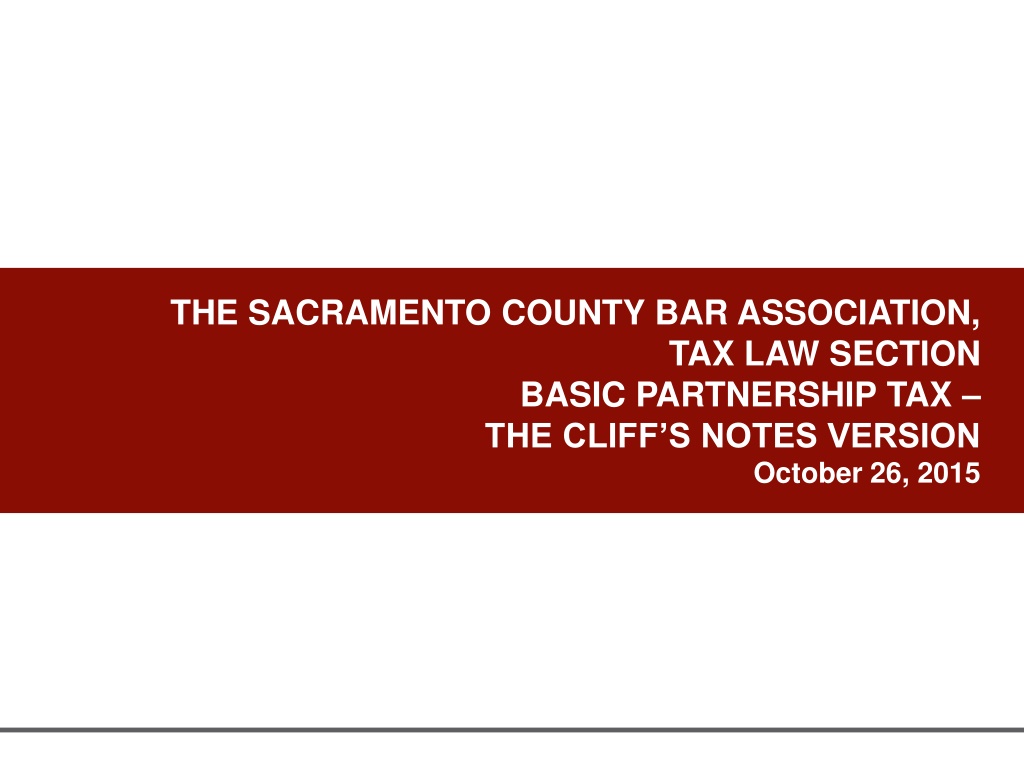




![Town of [Town Name] Real Estate Tax Rates and FY 2024 Budget Summary](/thumb/62211/town-of-town-name-real-estate-tax-rates-and-fy-2024-budget-summary.jpg)



